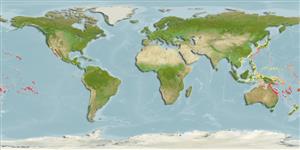>
Holocentriformes (Squirrelfishes, soldierfishes) >
Holocentridae (Squirrelfishes, soldierfishes) > Myripristinae
Etymology: Myripristis: Greek, myros, -ou = male of morey eel + Greek, pristis = saw (Ref. 45335).
More on author: Greenfield.
Environment: milieu / climate zone / depth range / distribution range
Ökologie
seewasser riff-verbunden; tiefenbereich 2 - 15 m (Ref. 12419). Subtropical
Pacific Ocean: Cook Islands (Ref. 34027), Tonga (Ref. 53797), Rapa, Pitcairn, and Easter Island.
Size / Gewicht / Alter
Maturity: Lm ? range ? - ? cm
Max length : 26.5 cm NG Männchen/unbestimmt; (Ref. 89467)
Life cycle and mating behavior
Geschlechtsreife | Fortpflanzung | Ablaichen | Eier | Fecundity | Larven
Randall, J.E. and D.W. Greenfield, 1996. Revision of the Indo-Pacific holocentrid fishes of the genus Myripristis, with descriptions of three new species. Indo-Pac. Fish. (25):61 p. (Ref. 12419)
IUCN Rote Liste Status (Ref. 130435: Version 2024-1)
Bedrohung für Menschen
Harmless
Nutzung durch Menschen
Tools
Zusatzinformationen
Download XML
Internet Quellen
Estimates based on models
Preferred temperature (Ref.
123201): 23 - 28.8, mean 26.6 °C (based on 720 cells).
Phylogenetic diversity index (Ref.
82804): PD
50 = 0.5000 [Uniqueness, from 0.5 = low to 2.0 = high].
Bayesian length-weight: a=0.01950 (0.00901 - 0.04219), b=3.03 (2.85 - 3.21), in cm total length, based on LWR estimates for this Genus-body shape (Ref.
93245).
Trophic level (Ref.
69278): 3.5 ±0.5 se; based on size and trophs of closest relatives
Widerstandsfähigkeit (Ref.
120179): hoch, Verdopplung der Population dauert weniger als 15 Monate. (Preliminary K or Fecundity.).
Fishing Vulnerability (Ref.
59153): Low vulnerability (16 of 100).
Nutrients (Ref.
124155): Calcium = 45.6 [18.5, 119.4] mg/100g; Iron = 0.71 [0.27, 1.51] mg/100g; Protein = 19.4 [18.1, 20.6] %; Omega3 = 0.218 [0.085, 0.537] g/100g; Selenium = 12.2 [6.1, 27.3] μg/100g; VitaminA = 44 [14, 145] μg/100g; Zinc = 0.921 [0.553, 1.535] mg/100g (wet weight);
